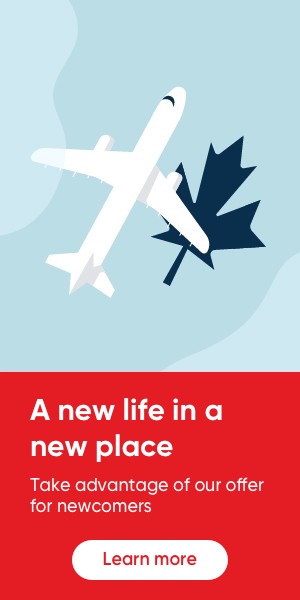What is the Canadian currency?
Canada’s official currency is the Canadian dollar. Its currency symbol is $, and its international code is CAD. If you’re visiting Canada, it’s a good idea to have some Canadian dollars on hand before you arrive to make your first purchases.
You can get Canadian cash at a financial institution, foreign exchange office or ATM. If you’re coming from abroad, pay attention to the exchange rate and foreign exchange office fees. And feel free to compare different services to get more value for your money.
Good to know: Canadians are using cash less and less and prefer to pay with debit cards, credit cards or mobile apps.
What do I need to know about bank accounts in Canada?
You’ll need to open a Canadian bank account for your daily transactions. All accounts allow you to deposit and withdraw money, while some allow you to make purchases, transactions and bill payments, as well as write cheques. You can also have your pay deposited directly into your account. With a bank account, you have access to your money at all times and can manage your financial assets much more easily.
There are different types of bank accounts
The two main types are chequing accounts and savings accounts. You can access them using your debit card.
- A chequing account allows you to make a number of transactions, such as deposits and withdrawals.
- A savings account allows you to deposit money you don’t need for day-to-day expenses. You could use it, for example, to build an emergency fund.
Foreign currency accounts are also available.
Opening a bank account in Canada is easy
At some financial institutions, such as National Bank, you can open an account online, whether you’re abroad or in Canada. All you have to do is go to a branch to complete the process.
You’ll need to provide certain official documents, such as a valid passport and, if you’re coming from abroad, a document from Citizenship and Immigration Canada.
You can choose the best package for your needs. If you make a lot of transactions, you might consider an account with unlimited transactions. If you don’t think you’ll be making a lot of transactions, consider an account with a lower monthly fee.
You can use online banking services
More and more banking services are available online, including Interac e-Transfer®, which is a secure way to send money to anyone in Canada, no matter what their financial institution, in just a few clicks.
You can also send money to family and friends abroad using an international transfer service.
You can perform a variety of operations and transactions securely on your computer or smartphone. Check out the benefits and features of the National Bank platform.
Can I use personal cheques?
You can easily pay or be paid with cheques, although they are becoming increasingly obsolete. A traditional cheque is a rectangular piece of paper with security features and includes information such as your contact information and that of your financial institution.
Learn to read the numbers on a cheque.
Is your employer asking for a “specimen cheque”? This is common practice for depositing your pay directly into your account.
Governments may also ask you for one if you want to sign up for direct deposit for certain payments, such as a tax refund.
If you provide a paper cheque, be sure to write the word “VOID” on it in big letters. You can also get a digital version through your financial institution’s online portal.
What are the differences between a credit card and a debit card?
Manage your finances more confidently in Canada with our practical guide
Learn more about the financial system and how to make a personal budget, manage a bank account, your savings, and your investments.
- A debit card is issued by your financial institution so you can access your bank accounts, withdraw cash and make purchases that are automatically debited from the selected account.
- A credit card is a payment tool issued by your financial institution that allows you to make transactions within your credit limit and repay them within a number of days.
There are several differences between a debit card and a credit card. To guide you in applying for a credit card, learn more about how they work and how to choose one.
What a credit card allows you to do
Having a credit card in Canada allows you to:
- Make purchases in stores and online and pay for various services quickly and securely, thanks to fraud protection measures like zero liability and the ability to dispute transactions.
- Take advantage of benefits like purchase insurance (including coverage against theft), extended warranties and rewards programs that offer cashback or let you earn points that you can redeem for gift cards or travel discounts.
- Build your credit history, which various entities may consult to find out about your payment habits, like paying your monthly balance.
- Improve your credit score, which lenders use to assess your level of risk when you take out a loan, for example. Having a good score may make it easier for you to get loans, such as a mortgage. Good credit may even help you get better rates.
Credit card applications can be completed online, in-branch or by phone.
Have a look at some tips on how to use your credit card properly and advice on choosing the best card for your needs.
You can use ATMs
You can use your debit and credit cards to access your bank accounts at an ATM (automated teller machine), allowing you to deposit and withdraw cash.
You can also use a credit card to get a cash advance, but be aware that you’ll pay interest charges from the day the funds are withdrawn. Interest charges will stop only once you’ve paid back the full amount.
Depending on the banking package you choose, the number of transactions you can make each month may be limited. Be sure to carefully assess your needs when choosing your package, and know that you can always change it.
Also note that if you use an ATM that’s not owned by your banking institution, you may have to pay a fee to withdraw money from your bank account.
What is a line of credit?
You can apply for a line of credit at your banking institution. It allows you to borrow a certain amount of money, which you must pay back with interest. Generally speaking, interest rates on a line of credit are lower than those for other types of loans.
A line of credit is useful for taking advantage of opportunities that come up, responding quickly to unforeseen events, undertaking projects or covering payments due at higher interest rates.
How do you get a mortgage?
When buying a home, you’ll probably need a mortgage to finance it.
You can consult a mortgage broker to find the best solution for you. You can also make an appointment with a branch advisor to learn about the programs your financial institution offers.
Be aware that to buy a property in Canada, you’ll need a minimum down payment based on the price of the home. In addition, if you want to buy a home with a down payment of less than 20%, you’ll need mortgage loan insurance. The amount of your premium will be calculated based on your down payment.
Learn more about buying a home in Canada.
What financial products can you use to grow your savings in Canada?
Saving money is a good habit, whether it’s to build an emergency fund, put money away for your retirement, take a trip or carry out renovations or other projects.
We recommend consulting a personal financial advisor to help you make the right choices, as savings programs have rules, limits and conditions. When you use them properly, you pay less tax while generating income through interest.
An RRSP for your retirement
One of the most popular financial products is the registered retirement savings plan (RRSP). As its name suggests, its purpose is to build a fund for your retirement. You can deposit a certain percentage of your annual income into your RRSP. That amount is deducted from your annual taxable income, which means you pay less income tax. What’s more, the interest it earns is not taxable. But be aware that you’ll have to pay tax on the amounts saved when you withdraw them from your RRSP.
A TFSA for your short-term projects
You can deposit money each year into a tax-free savings account (TFSA) and withdraw it at any time. The interest it earns is not taxable.
An RESP for your children’s education
A registered education savings plan (RESP) is specifically designed to finance your children’s post-secondary education. It allows you to save money tax-free and receive grants from the federal and Quebec governments.
Other types of savings plans may be of interest to you depending on your situation or age.
In short, the Canadian banking system is a network of institutions, services and programs that cover all your financial needs. Over time, you’ll become more familiar with its complexities. Feel free to contact an advisor to get answers to your questions.




